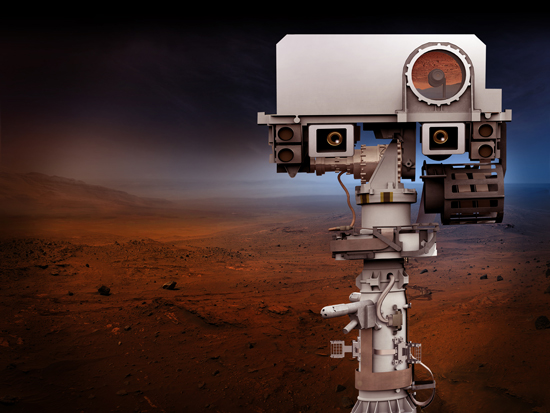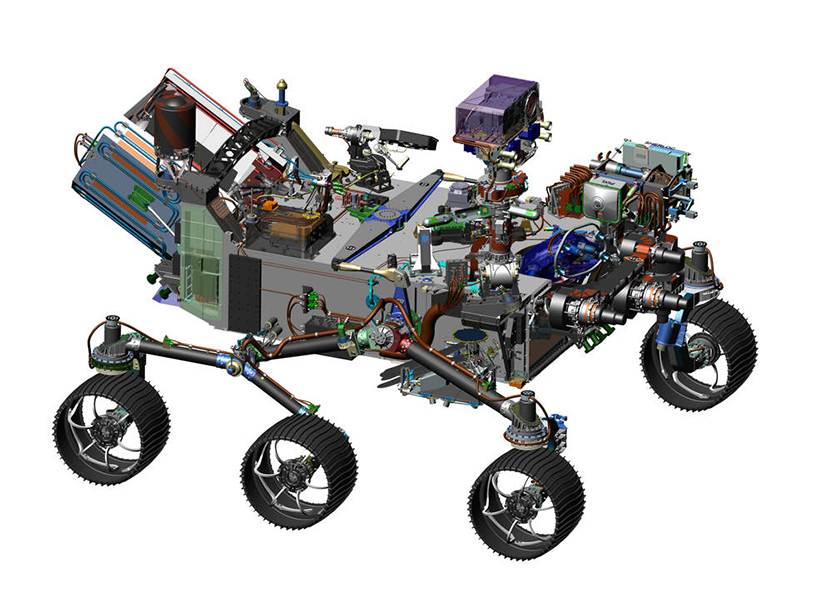To scientists and engineers working on Mars rovers, a rover’s entry into the Martian atmosphere and descent to its surface are known as the 7 minutes of terror. Hurtling at speeds exceeding 17,700 kilometers per hour, a rover has to put on some serious brakes if it means to land nimbly and delicately at the surface.
The process may be less terrifying during the next mission thanks to the new Mars 2020 rover design that gives the craft more control as it lands. The NASA rover team announced plans for the craft on 1 July during a live Facebook question and answer (Q & A) session streamed from the Jet Propulsion Laboratory in Pasadena, Calif. At the Q & A, managers highlighted how new robotic features distinguish the Mars 2020 rover (named for its scheduled launch year) from past models sent to explore the Martian surface.
The Mars 2020 rover will have a smarter parachute deployment system and a navigation system that uses pictures to guide landing.
The new craft will look much like Curiosity—its six-wheeled, 1-ton predecessor launched November 2011. However, the Mars 2020 rover will have, among other features, a smarter parachute deployment system that will help it maneuver into an even tighter landing zone, a navigation system that uses pictures to guide landing, and even equipment to record ambient sound on Mars.
Equipped for a Rocky Landing
Because Curiosity relied upon velocity to activate parachute deployment and because it could not make decisions based on position, the craft opened its chute after passing below the ideal altitude. The Mars 2020 rover aims to avoid this nail-biting entry, said Allen Chen of the descent and landing team.
“By adding what’s known as range trigger, we can specify where we want the parachute to open, not just at what velocity we want it to open,” said Chen. In other words, certain altitudes could be programmed to trigger the chute. “That shrinks our [required] landing area by nearly half.”
The technique will help the rover avoid hazardous terrain by automatically comparing photos the rover takes of the landing zone with an onboard map.
What’s more, the Mars 2020 rover will be equipped with terrain relative navigation, which uses pictures of the ground for orientation during entry and descent. The technique will help the rover avoid hazardous terrain by automatically comparing photos the rover takes of the landing zone with an onboard map generated from images previously taken by orbiting craft.
Curiosity took pictures of the surface during landing, but they were not matched to a map to facilitate better navigation. Instead, Curiosity and other previous rovers were sent to spans of flat, rock-free terrain at least 20 by 25 kilometers across to ensure that the landing location was safe. The craft then drove long distances to gather information and photograph rocky terrain.
In contrast, the range trigger and navigation system will allow the craft to maneuver into a tighter landing zone—a flat space a mere 18 by 14 kilometers across, half the prior area—surrounded by rock. Allowing the exact landing target to change in response to what the craft sees upon descent will help the Mars 2020 rover to immediately begin collecting samples, Chen explained.
“One of the key things for us is to land in an environment that has a lot of rocks, and rocks are challenging for landing,” said project scientist Kenneth Farley from the NASA Mars Yard—a parking lot full of bedrock and red slab used to test-drive rover models. “Fortunately, we have some new capabilities with the landing system that will allow us to get into this tricky terrain.”
Collecting Martian Rocks

The Mars 2020 rover will land in any one of eight potential locations thought capable of once hosting microbes. Curiosity was sent to photograph areas that might have once been inhabitable, and using these data as well as information collected by other craft, researchers have now confirmed rock formations that appear to have been river beds, tsunami zones, and deltas.
In addition to taking photos, the Mars 2020 rover will collect 35 samples of rock for 7 months after arriving on the Red Planet. The rover will leave samples in designated locations for a second craft to retrieve at a later date. In contrast, Curiosity was equipped with gas analysis instruments and transmitted data about organic molecules, but no samples were returned to Earth.
NASA is currently testing the new rover’s drilling tools on a variety of Earth’s rock types. In addition, scientists are conducting drilling tests in a chamber that emulates Martian atmospheric pressure, which is only about 1% of that found on Earth, according to Matt Robinson of the Mars 2020 sampling and catching team. Robinson gave a live tour of the testing chamber and drilling facility during the Q & A.
The Mars 2020 rover will have a five-jointed robotic arm that can retrieve core samples for storage and transport, Robinson noted.
Searching for Water, Creating Oxygen, and More
In a press release sent after the conference, NASA announced that it has concluded an extensive review process and will now proceed with final construction designs. Several intriguing instruments made the cut.
The Mars 2020 rover will be equipped with a ground penetrating radar called the Radar Imager for Mars’ Subsurface Experiment (RIMFAX), which will be used to search for ice and brine beneath the rover. In addition, several microphones will record Martian sound for the first time.
A device that ingests carbon dioxide from the atmosphere and produces oxygen using solid oxide electrolysis will also be included on the rover. If the device, the Mars Oxygen In Situ Resource Utilization Experiment (MOXIE), is successful, it could pave the way for instruments that allow people to breathe on the Martian surface. The technology could also help overcome the need to transport oxygen for fuel.
Because of these and other new designs such as thicker wheels that avoid punctures and damage, the Mars 2020 rover will weigh about 150 kilograms more than Curiosity.
The team affirmed that information transmitted by the Mars 2020 rover will appear immediately on open-access websites, allowing the public to review information at the same time as NASA scientists. Images and data will travel at the speed of light and reach Earth from Mars in 20 to 25 minutes, depending on the position of both planets in their orbits.
—Amy Coombs, Editorial Intern
Citation:
Coombs, A. (2016), Precision landing will be key to NASA’s Mars 2020 rover, Eos, 97, https://doi.org/10.1029/2016EO056219. Published on 21 July 2016.
Text © 2016. The authors. CC BY-NC-ND 3.0
Except where otherwise noted, images are subject to copyright. Any reuse without express permission from the copyright owner is prohibited.

